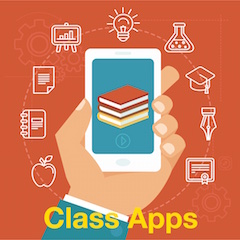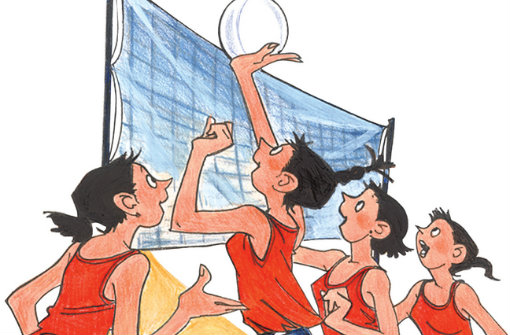Is Your Teaching More Ping-Pong or Volleyball?
A MiddleWeb Blog
 As a teacher, I sometimes get too comfortable – and satisfied – with a ‘ping-pong’ approach to questions and discussion that merely bounces information back and forth between my students and myself.
As a teacher, I sometimes get too comfortable – and satisfied – with a ‘ping-pong’ approach to questions and discussion that merely bounces information back and forth between my students and myself.
I tend to formulate a question (often with a predetermined answer), serve it out to class, and wait for a student to respond.
Then I either affirm the student’s ‘correct’ answer or – if they are off-track – rephrase their response or follow it up with an additional question to ensure that we all arrive at the ‘correct’ response.
This ‘ping-pong’ approach feels controlled and safe, and practically guarantees that we travel in a linear path to the ‘proper’ destination. Unfortunately, it also sends the message that my role is to dish out information, and the student’s role is merely to receive it and give it back to me.
There is nothing wrong with using questions to prompt and probe students…or to help focus their learning. But as often as possible, teachers should seek to get students more actively involved in divergent, critical thinking, questioning, and discussion.
The Volleyball Approach
In contrast, recently one of my sons and I attended a collegiate volleyball game. I noted how the coaches on both sides displayed calm confidence in their players and offered rare but specific encouragement and feedback. What really struck me was how the reaction was the same whether a team scored…or gave up a point! In both scenarios, the players high-fived each other and shouted words of encouragement.
At one point in the match, it seemed that neither team would score. There was a long, back-and-forth battle during which my son commented how ‘cool’ it was to see players take their time and work together to set up the perfect shot. The longer it took for either team to score a point, the more excited he became. It was the ‘wrestle’ – rather than the outcome – that he enjoyed.
Teachers would do well to adopt a similar, ‘volleyball’ approach in the classroom by…
- Framing lessons with thought provoking essential questions that spark discussion and debate.
- Crafting questions at different degrees of challenge and in different cognitive domains.
- Asking inferential/analytical questions that require students to justify their answers and to explain their thinking.
- Modeling and providing students with practice in creating their own questions and in responding to questions posed by their peers.
- Allowing students plenty of time think, write, discuss, and revise their responses.
- Structuring student-centered discussions like fishbowls and Socratic seminars.
Technology Tools for Fostering Questioning and Discussion
Depending on the type of question or discussion a teacher has in mind, there are a variety of tools available to help facilitate the process – some old and some emerging.
Padlet is an easy-to-use tool for gathering/sharing student responses and for modifying them later. Teachers can pose questions to students. Students can post responses or questions. One of the newer Padlet features includes the option to turn on (or off) the ability for students to comment on the posts of their classmates. A brief tutorial for getting started can be found here.
TodaysMeet is a backchannel app that can be adapted as online discussion tool for students to contribute comments or ask questions during a presentation. It can also be used for conducting online discussions during and outside of class. Students can join a conversation easily with no registration and take part in powerful conversations that augment the traditional classroom.

Teachers and students can interact and review responses in real time. Teachers can control the timing or launch homework sessions in which students move through at their own pace. Either way, teachers are aware of who is and who isn’t responding to questions, which helps with classroom management and reinforces appropriate use of technology in the classroom.
Google Forms and SurveyMonkey are two tools great for posing questions to students, gathering their thoughts and responses, and compiling quick data charts based on the results.
Poll Everywhere is a free, versatile tool for posing questions to students during and/or outside of class. Students can respond to a variety of open-ended, multiple choice, or ranking questions designed by the teacher from any internet-connected device or smart phone. Student responses can be displayed in real time or saved for later. Students could also create polls as a cross-teaching strategy.
Deepening Questions and Discussion
Powerful questions and deep discussion serve as the lifeblood of learning. They activate students’ prior knowledge, deepen their understanding, and invite learners to engage in challenging cognitive tasks (Dean, 2012). Questions and discussion can also be used to improve recall of information and to assess and provide feedback to students (Craig et al., 2006).
Too often, however, questions and discussion are teacher-driven. Consider these words from researcher John Hattie (2012):
For teachers, questions are often the glue to the flow of the lesson, and they see questions as enabling, keeping students active in the lesson, arousing interest, modeling enquiry, and confirming for the teacher that ‘most’ of the students are keeping up.
While this teacher-driven approach isn’t always bad—we can certainly do better. Our goal should be to foster discussion that encourages students to respond thoughtfully and thoroughly to a range of questions and to pose many questions of their own.
References
Craig, S. D., Sullins, J., Witherspoon, A., & Gholson, B. (2006). The deep-level-reasoning-question effect: The role of dialogue and deep-level-reasoning questions during vicarious learning. Cognition and Instruction, 24 (4), 565– 591.
Dean, C. B. (2012). Classroom instruction that works: Research-based strategies for increasing student achievement. ASCD.
Hattie, J. (2012). Visible learning for teachers: Maximizing impact on learning. Routledge.



































A strategy I really like is Written Discussion. Smokey Daniels lists it as his number one most important teaching strategy ever. After using it throughout the past two years, I understand why. My students refer to it as texting on paper. Although they would prefer to use devices, I like the paper method. It gets them thinking and writing and addressing the essential questions I select. I recently used this strategy in place of a traditional test. I gave out a list of questions that had to be in the discussion, and let students respond. I did require them to respond to all parts of each multi-part question I provided. Those who are unfamiliar with the strategy may start here https://twowritingteachers.org/2014/10/12/written-conversations/
Uplifting and refreshing. This link provides informative ideas